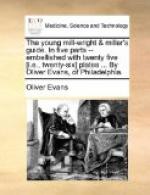|
This section contains 367 words (approx. 2 pages at 300 words per page) |
Encyclopedia of World Biography on Oliver Evans
Oliver Evans (1755-1819) was one of America's first and most important inventors. He made major contributions to the technology of flour milling and steam engines.
Oliver Evans was born near Newport, Del. He was apprenticed to a wagon maker. About the age of 21 he began work on his first important invention: a machine to make the cards with which wool was brushed preparatory to spinning. In 1780 he married and joined his brothers in a flour milling business near Wilmington, Del., the center of that industry. Within 5 years he had made spectacular improvements in the ancient design of flour mills; these remained standard for a century.
Previously flour mills had required an enormous amount of difficult hand labor, and the flour was often dirty as a result. By harnessing the energy of the water-wheel to move the grain and flour both horizontally and vertically through the mill, Evans reduced the hand labor and improved the product's cleanliness. Although he patented his improvements, he had great difficulty in enforcing his legal rights to the invention. Soon after making these improvements, he moved to Philadelphia and established a manufactory of mill equipment.
Evans then turned to a problem which had long interested him: the production and harnessing of steam power. James Watt's low-pressure engine had been introduced into America by 1802, when Evans began to operate his first high-pressure engine. In the Watt engine, steam was condensed in the cylinder, creating a vacuum so that atmospheric pressure pushed the piston down. In Evans's new engine (which was independently invented in England at the same time) the steam was introduced into the cylinder under high pressure and used to push the piston down directly. In 1804 Evans built a steam-powered amphibious vehicle, but his hopes to introduce steam vehicles on common roads were not realized. However, his high-pressure engines soon became standard for American mills, railroads, and steamboats.
By the time Evans died in 1819, his large iron foundries in Philadelphia and Pittsburgh were turning out quantities of steam engines, mill equipment, and other types of ironwork. His two books, The Young Mill-Wright and Miller's Guide (1795) and The Abortion of the Young Steam Engineer's Guide (1805), were America's earliest handbooks on those subjects.
|
This section contains 367 words (approx. 2 pages at 300 words per page) |


